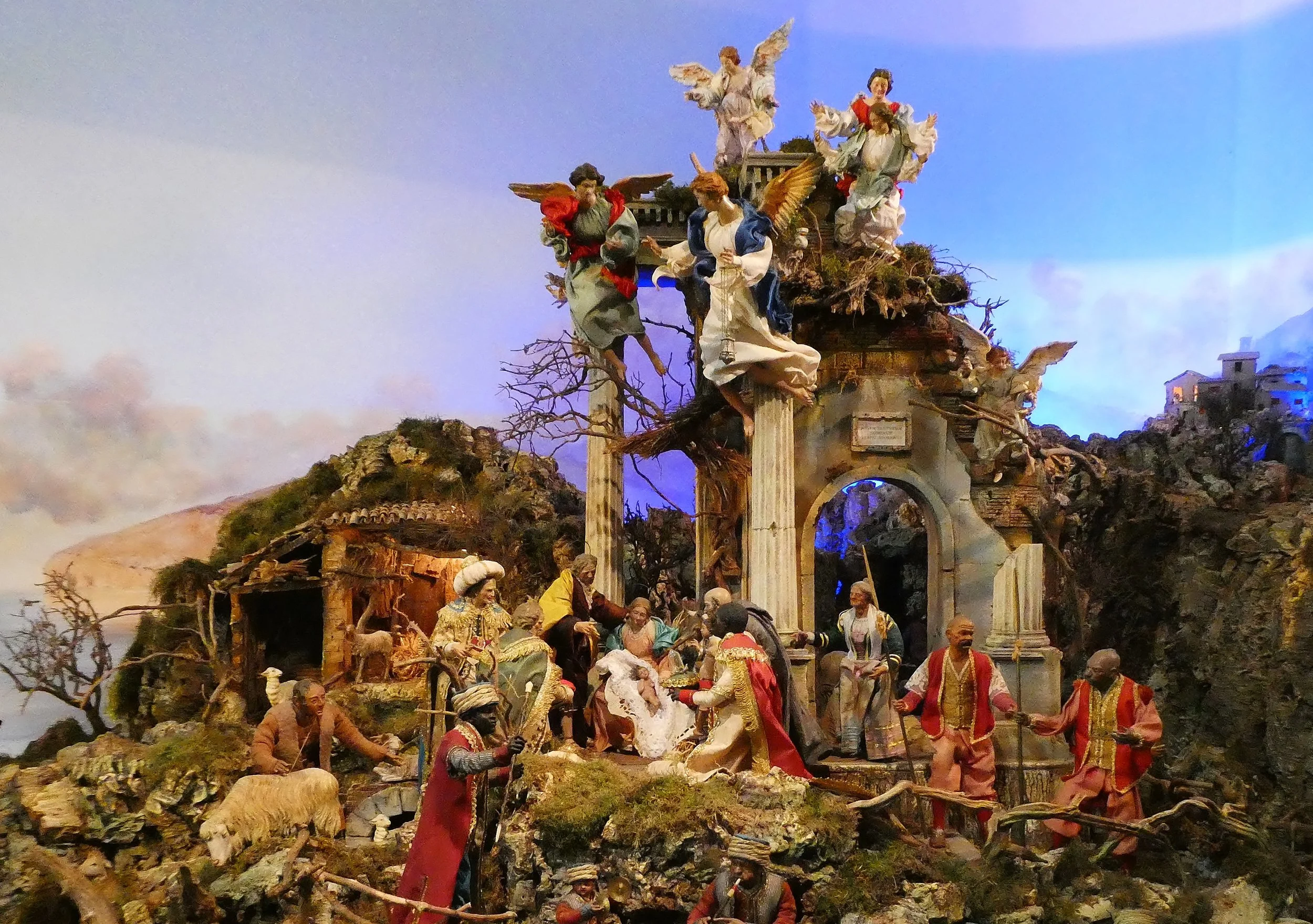Loggia of the Sedile Dominova
Bethlehem at the Workers’ Club
In Sorrento, where Via San Cesario and Largo Padre Giuliani meet, you’ll find a handsome loggia forming the corner of a venerable building. Two sides are open, framed by great Romanesque arches made of piperno, a dark stone that comes from the volcanic “burning fields”, the Campi Flegrei, west of Naples. Across the street at one of Bar Monnalisa’s outdoor tables, you can admire the frescoes inside the loggia, with elaborate trompe l’oeil arches to match the real ones. Lately, the 18th century frescoes wear strips of thin cotton, like giant sticking plasters, over cracks in the walls. The cracks are reminders that in this corner of Italy, just down the road from Pompeii, molten magma moves restlessly not far below. The plaster walls are old, but the building itself is much older, having been built in the 14th century, while southern Italy was still ruled by the French Angevin dynasty.
“Sedile Dominova” the building is called, which means, approximately, “the Seat in the New House”. In the days when Charles of Anjou’s descendants reigned, it was the Seat, or Sedile, of an assembly of noblemen who met here, under the arches, to establish policy for the town. Nowadays the loggia contains simple tables at which you’ll usually find some of Sorrento’s pensionati reading newspapers or shuffling 40-card decks for friendly games of Briscola. They probably won’t object if you want to enter and study the frescoes close-up; they’re used to it. But the building is, in fact, theirs – because in 1877, it became the property of the Società Operaia per il Mutuo Soccorso – the Workers Mutual Aid Society, dedicated to helping those who, because of old age or illness, could not work.
The Presepe in the Workers’ Club Loggia
Strolling along Largo Giuliani one mild winter afternoon, I stopped beside the arches of the Workers’ Club and, through the iron railing, I noticed that the frescoes on the opposite wall, inside the loggia, were obscured by a large wooden structure rather like a huge bed with a canopy. Curious, I mounted the three steps at the entrance, and nodded to a gentleman dozing in his chair, who awoke long enough to wave me hospitably inside.
In the “bed”, I was startled to see a miniature rocky landscape of hills bordering a narrow gorge, with a procession of wonderfully detailed figures seeming to march through the gorge and up a winding path toward a ruined pagan temple. Above the temple hovered several angels; and looking closely, I could see, in the temple, the traditional Nativity scene: Joseph, Mary and her child, and a turbaned visitor from the East bearing gifts; while a shepherd, among his flock, gazed from a distance.
The Nativity Scene
Other gift-bearers were on the path, including a young potentate sitting grandly atop a mighty, richly caparisoned elephant; but all along the way, there were hundreds of other figures, including ordinary folk absorbed in their own lives: peasants enjoying a meal of beans, bread and fruit; a farm woman selling dried peppers, garlic, and artichokes from the door of her house; an Acquaerolo, or water-seller, carrying his wooden cask on his shoulder. The figures were exquisitely detailed and costumed, their faces lifelike and expressive. There were animals, too: dogs, pigs, even a turkey. Behind the whole scene was a painted backdrop looking suspiciously like the Bay of Naples, rather than the hills of Judea.
The Young Potentate
Of course Nativity scenes are a familiar feature of the Christmas season all over Europe and the Americas. In Italy, they are a long-treasured tradition; every year a bigger-than-life presepe appears in front of the obelisk in St. Peter’s square; churches everywhere feature them with pride; and even at home, tabletop scenes tell the Christmas story.
But Neapolitan and Sorrentine presepi are different – nativity scenes plus, you might call them – as I discovered later when I visited an exhibit space in the Bastione of Sorrento’s medieval walls. There, I saw superbly executed figures and settings for presepi, created by a local Maestro d’arte Presepiale named Federico Iaccarino; and I learned that many of the miniature figures are characters in a rich southern Italian tradition of folklore and legend, somewhat beyond the biblical. Like Stefania, for example. The legend says that ancient Jewish law prohibited young childless women from visiting a new mother. But Stefania was desperate to see the Christ child, and came to see him carrying a large stone wrapped in blankets. When she knelt, the stone coughed and became a human child – St. Stephen, in fact, the first martyr, who was later stoned to death. Then there’s La Zingara, a soothsaying gypsy who foretells the Passion of Christ; Il Pescatore, the fisherman, foreshadowing Simon and Andrew, Christ’s “fishers of men”; L’oste, the host or innkeeper, representing the temptation of gluttony and ease; and Il Benino, a rustic constantly asleep, who misses the miraculous event.
The Host Vignette, by Federico Iaccarino
I’ve heard there is a street in Naples, Via San Gregorio Armeno, lined with shops selling finely crafted presepi. It is famous, open all year, and visited by hundreds of thousands of people. Some of the artisans update their scenes with characters from today’s culture: politicians, actors and the like. I’m sure it would be great fun to visit, and perhaps I’ll go there next time I’m in Napoli. But I’d really rather not see Simon Cowell critiquing the Wise Men, so I’m glad my first taste of this time-honoured art was here at the Workers’ Club, where a friendly fellow waved me in, and then, rather than trying to sell me anything, went quietly back to sleep.
Text © 2019 by Joe Gartman; Photographs © 2019 by Patricia Gartman. First published in Italia! Magazine, December 2019




